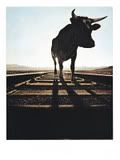Alvin was cursed and blessed three times over, a bisexual black man with an artistic temperament.
Raised in the mean South Bronx of the 1950s, Alvin was diffferent enough from the other kids in the neighborhood that he learned how to fight, and how to end a fight fast.
Alvin's personal wars weighed a ton. Maybe Vietnam didn't look so bad by comparison. He joined the Navy in the mid-60s and found himself surrounded by men. His sexuality blossomed like a tough flower stabbing up through the slats of a Navy warship. And his art blossomed alongside his sex: he photoghraphed his fellow sailors in various states of erotic thrall, nude and fragile there in the bosom of the US Navy. Bodies, naked, cold and alive during wartime. Alvin was the ship's cook, and three decades later I was fortunate enough to have him serve me the same salt cod, the same greens, the same delicious corn and potato mash that he made for the men he photographed, the men he fucked, the men he went to war with, back in the '60s.
With these men he was told to stand on deck one day, exposed, as US warplanes did a flyover and delivered a payload of chemicals down onto the unsuspecting crewmen.
Then the checkups started, weekly "visits" with the shipboard Navy doctors, who duly noted it all down in little notebooks: the changes in respiratory health, the immune functioning or debasement thereof, the white blood cells, the tumors....
Alvin and his shipmates were guinea pigs in a military medical experiment. They had been exposed to Agent Orange in advance of the Army bringing it full-on to the jungles of what had once been French Indochina. It happened a lot during Vietnam. It happens all the time, as the continuing rise of Gulf War Syndrome attests.
When I moved in to the apartment across from Alvin's in the Lower East Side of Manhattan in 1999, Alvin was a massive presence, the Mayor of the block and the Lord of the stoop. He was imposing, a huge, dark-skinned man who always seemed to be sporting equal parts black leather and kinte cloth, kind of a gay S&M version of a Black Panther. His ornate jewelry was masculine, yet strangely beautiful -- usually twisted hunks of amber. He would hold court for hours on the stoop into the summer nights, smoking and telling tales of his sexual adventures on the piers as he sat in a little chair, regal with his mahogany figured African walking stick by his side.
As bridge-and-tunnel weekend kids cavorted around the streets -- skinny and white and rich -- having S&M theme bachelorette parties at a tourist trap restaurant nearby, Al would spit at the curb, and suck his teeth. "These children," he'd mutter. "They don't know.... If they want to see some EQUIPMENT, they can come up to my place." He'd pause, then raise his voice indignantly. "I got equipment!"
At this point, Alvin also had cancer. Lots of it. And advanced diabetes was robbing him of his circulation. It was a fifth-story walkup, and Alvin took a long time to make it down the stairs, longer still getting up. On bad days his stoic little moans would echo softly through the tenement halls. He leaned on his African carved walking stick, and he bit his lip. If you happened upon him and he didn't have time to adjust his expression before you saw him, he looked like a sweet, scared child.
Alvin told stories, colorful tales of his life in the 1970s, bar fights and drug deals, and sexual escapades that made even libertine me blush like a Victorian granny. Stories of driving his Econoline van down to the waterfront and throwing the doors open and getting laid as the sun rose. Of runaways staying in his bed, of jealous husbands, of jealous wives.
Alvin took photographs. That was his main art form and he was dedicated to it until the end. He left behind rolls of film, some developed, some printed, some just sitting there, that taken together attest to the vibrancy and the squalor, the tenderness and the ferocity, the dreamlike wildness of New York City in the 1970s. No AIDS. No 9/11. No urban renewal. Just a scrawl of horny technicolor beauty across a broken gray landscape.
Alvin belonged to a time and a place that is disappearing. More accurately, his presence refracted back the light and the color of a whole vivid world become a mirage. It dances like a fever dream as it fades from reality. It is the pre-AIDS gay world of New York City's piers and bathhouses, bars and illicit street corner fucks at dawn. Where untamed artsists like David Wojnarowicz painted hallucinatory murals that were terrible and gorgeous, beautiful and obscene, on abandoned warehouse walls. It is the wild side that Lou Reed suggested some of us might try taking a walk on. You can tsk-tsk it away, or you can romanticize it, but somewhere between those exaggerated reactions, it simply WAS. It was real life.
And the giant space it has left, not unlike a hole in the ground, serves to remind us that everything we take for granted, that seems as natural to us as air, is really fleeting, and will die.
Alvin died in a hospital room uptown. All of us who cherished him had a big party in his honor -- we laughed at stories and wondered at the many facets of this sweet, scary, genius outlaw freak lover pussycat mountain of a man, this artist whose canvas was everywhere.
And then we all went our separate ways.
Tuesday, January 9, 2007
Subscribe to:
Post Comments (Atom)


1 comment:
Peet - I know you're busy-busy - but I wish you'd write more; I really enjoy your thoughts!
Happy New year,
--D
Post a Comment